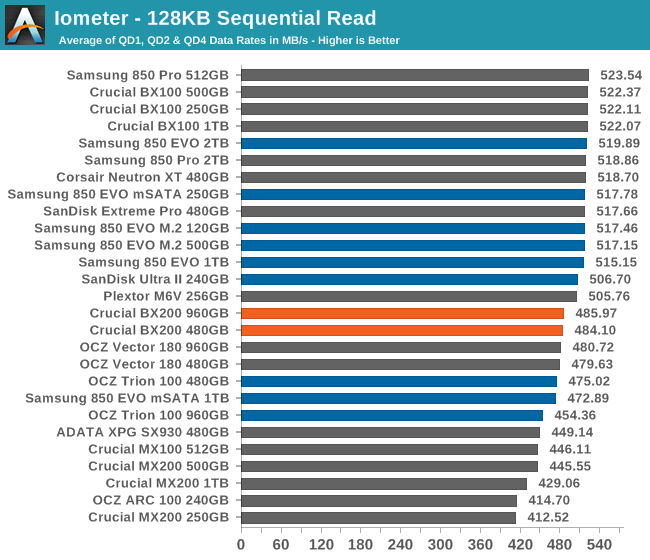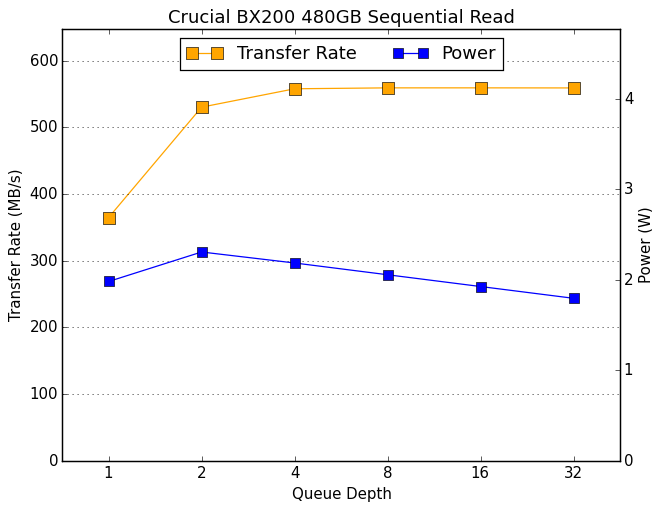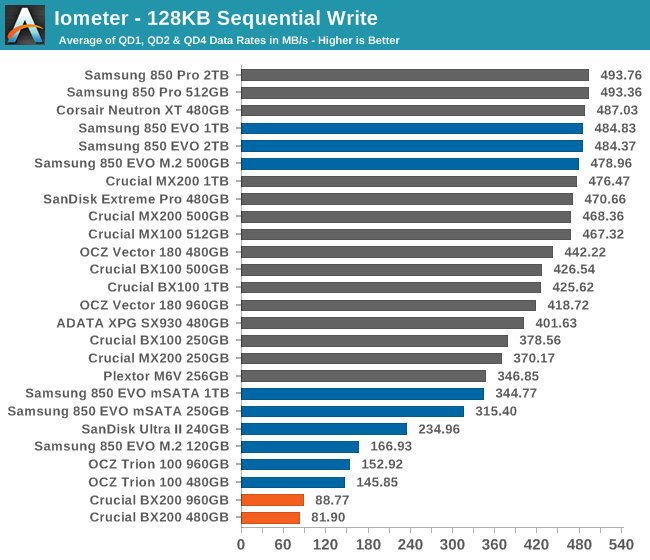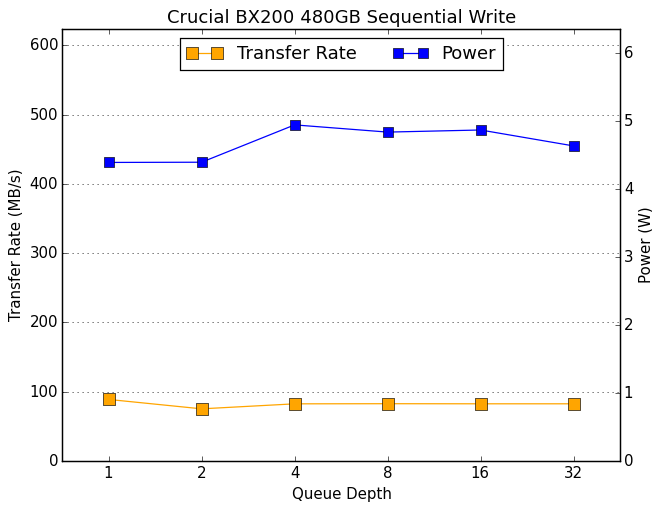The Crucial BX200 (480GB & 960GB) SSD Review: Crucial's First TLC NAND SSD
by Billy Tallis on November 3, 2015 9:00 AM ESTSequential Read Performance
Just like the random read test, sequential reads are tested across the span of a full drive and a representative sample of queue depths. This test performs 128kB reads. Most operations involving large files (typically images and videos) fall under this test's purveiw, but streaming or playing even the highest resolution videos doesn't require anywhere near the full bandwidth of a SSD. Copying files to another SSD or loading very large files into an editing program will more likely use all the speed that's available.

At last we see respectable performance from the BX200. Its sequential read speeds aren'te quite up to the SATA limit at low queue depths, but it can sustain solid performance. Unfortunately, for anyone holding out hope that the poor results we've seen so far may be a testbed issue, the otherwise respectable sequential performance puts that idea to rest.

Power consumption on sequential reads is actually good, though it won't catch up with the best of drives.
 |
|||||||||
| Default | |||||||||
Given a larger queue depth, the BX200 is actually able to reach the performance plateau of the SATA speed limit; it just takes a little longer than the top tier of drives. Given the performance, it's not surprising to see that power consumption doesn't grow much. The shallow but steady decline in power consumption for the 480GB drive may be a sign that it's able to do some prefetching and caching to reduce the number of times it has to read from the flash.
Sequential Write Performance
The sequential write isn't limited to a small span of the disk, as that usually doesn't make a difference for this performance metric. As always, our averages are of the lower queue depths, but scaling to higher queue depths is also investigated. Bulk file copies and recording uncompressed video are the kind of uses that depend on sequential write performance.

The initial good news we saw with the BX200's sequential read performance didn't last long. The drive's write performance is bad for sequential access just like random access, unfortunately displacing the Trion 100 as one of the worst drives in our current collection.

The BX200 power consumption during sequential writing is poor but not radically so. It would seem that Micron's TLC flash requires at most a little more power to write to than other TLC, and this drive is just wasting most of that power budget on background management.
 |
|||||||||
| Default | |||||||||
Looking at larger queue depths, performance drops slightly after QD1, and stays low as power consumption shifts around some but is always high. Neither capacity of the BX100 can sustain even 100MB/s of writes for a length of time.










85 Comments
View All Comments
ilkhan - Tuesday, November 3, 2015 - link
If a company is going to shoot for the value proposition, they really need to beat samsung by more than 10%. Paying an extra 10% to get a really solid drive like the 850EVO is just too tempting for anyone who does even the tiniest of research before buying.You either need to be the cheapest, best name brand recognition, or fastest. Crucial isn't any of those on the 250GB market.
AnnonymousCoward - Friday, November 6, 2015 - link
Crucial has better quality and is a U.S. company. You shouldn't give Samung so much credit.squngy - Thursday, November 26, 2015 - link
What does the county of the home office got to do with anything?Samus - Friday, February 19, 2016 - link
Support. Samsungs is a joke. Fortunately the 840 Evo is the only drive they've botched. Crucial has excellent support and an excellent track record to go with their products. Shows good QA. Wouldn't expect anything else from an Intel subsidiary.zeeBomb - Tuesday, November 3, 2015 - link
What's the difference between TLC NAND to MLC or SLC NAND again?Beararam - Tuesday, November 3, 2015 - link
http://www.tomsitpro.com/articles/flash-data-cente...dakishimesan - Tuesday, November 3, 2015 - link
http://www.anandtech.com/show/6337/samsung-ssd-840...coconutboy - Tuesday, November 3, 2015 - link
slc = premium, reliable, fast, expensive, etcmlc = middle ground
tlc = cheap, lowest reliability, but Samsung has gotten tlc quality up to a level sufficient for most non-enterprise users
https://en.m.wikipedia.org/wiki/Multi-level_cell
zeeBomb - Tuesday, November 3, 2015 - link
Okay awesome, thanks.FalcomPSX - Tuesday, November 3, 2015 - link
SLC NAND stores one bit per flash cell. MLC stores two bits per cell. and TLC stores three bits per cell.